Greenwich cross country course ready for the Olympics
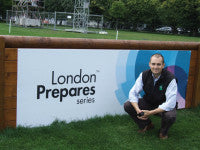 "It is certainly the most complex sportsturf contract that the STRI have ever been involved with"
"It is certainly the most complex sportsturf contract that the STRI have ever been involved with"
Lee Penrose, STRI Strategic Projects Manager
Greenwich Park is to provide a spectacular site for the equestrian and modern pentathlon events at the 2012 Olympics, set in seventy-three hectares of lush parkland with views across the capital. Yet, it has not been an easy road to create an Olympic venue - complete with a world-class cross country course - from scratch. There was opposition from locals and others who feared that the development would irreparably damage a historic park, and the venue has had to remain largely open to the public throughout its construction.
With eventing specialist, Tim Hadaway, as equestrian manager for the London Olympics Organising Committe (LOCOG), the challenge was set in 2008 to assess whether the exacting standards of modern equestrian sport could be met on such a sensitive site. The plan was to develop a world class cross country course, with temporary fences (jumps), making use of the topography and landscape of the historic park.
The STRI was initially involved in the scoping exercise, at the end of 2008, to establish how the turf surface in the park could be brought up to the required standard  within the constraints of the site, and its proposals became an essential part of the planning application that was required for the construction to go ahead.
within the constraints of the site, and its proposals became an essential part of the planning application that was required for the construction to go ahead.
"During 2009, we produced a method statement that was used to get the planning permission, and supported LOCOG in public meetings and presentations," explained Lee Penrose, STRI Strategic Projects Manager. "We had to plan the development of the cross country course, literally on a metre by metre basis, to achieve the standards required for an Olympic competition within the constraints of the site."
On every part of the site, there were ecological features to consider. Greenwich Park has more veteran trees than any other park in the country, as well as a number of rare habitats, including acid grasslands. And then there were the archaeological features - the all-weather arena at the centre of the course is surrounded by a parterre which could not be altered in any way, while the planned site for one of the fences was a Roman temple.
"These features had to be protected anywhere that the course ran over or alongside them, and this affected everything from the type of equipment used to vehicle movements on the course," explained Lee. "It is certainly the most complex sportsturf contract that we have ever been involved with."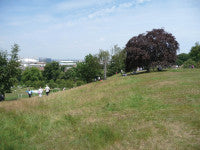
The plan of action to develop and construct the course involved using aerial photographs and detailed maps to precisely chart the location and nature of the sensitive areas, and the work has required constant monitoring to ensure that the LOCOG contractors meet the exacting planning requirements.
GPS mapping and guidance has proved an essential tool for this, ensuring that machinery operators are always aware of any protected features.
"For example, we couldn't just vertidrain to a uniform depth around the course because of the risk of hitting archaeological works," said Lee.
However, even this was not straightforward - a steep south-north gradient on the site, and shading from the numerous trees, meant that basic GPS systems could 'drop out' all too often. Lee approached positioning equipment specialist Trimble, who were working on a system using Real Time equipment specialist Trimble, who were working on a system using Real Time Kinetic (RTK) and GLONASS signals to give machine guidance within 2cm accuracy.
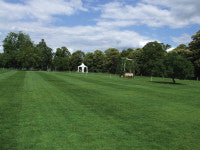 "The system hadn't been launched at the time in the UK, but the company worked with us to get the technology right. Our drivers have an RTK receiver on their machine and a display screen which shows exactly where they are working and if any sensitive features are close by."
"The system hadn't been launched at the time in the UK, but the company worked with us to get the technology right. Our drivers have an RTK receiver on their machine and a display screen which shows exactly where they are working and if any sensitive features are close by."
Preparing the full 5,800 metre cross country track, which loops around the park and, in places, widens significantly to accommodate combination fences or those with alternative routes through them, involved mainly standard turf establishment equipment and techniques.
After aerating and decompacting the existing surface, an improved sward was planted with a drill seeder, and then irrigated and fertilised. But, at every stage, the constraints of the site had to be considered.
"We were only able to decompact to a set depth, and it was not always possible to use heave because of archaeological features and works," explains Lee. "So, it has to be an ongoing process to get the benefits of decompaction, and the GPS equipment has been vital to identify vulnerable areas."
The course was seeded with a single variant of ryegrass to avoid the spread of invasive species such as fescues into the native grassland.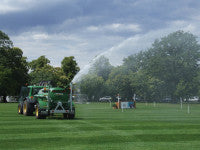 During the reinstatement phase, ryegrass selective herbicide will be used to kill off the rye and restore the turf to acid grasslands.
During the reinstatement phase, ryegrass selective herbicide will be used to kill off the rye and restore the turf to acid grasslands.
Irrigation of the ten metre wide track presented a special challenge, as the ground in this area cannot be penetrated. Pipe systems and pop-up sprinklers were not an option.
"We developed a bowser system which is towed behind a GPS-guided tractor with a low level folding applicator bar," says Lee, "It is also fitted with a water cannon for areas which can't be driven on, so that they can be irrigated from the side."
Fertiliser had to be planned on a site specific basis too: "Around protected trees we used organic based fertilisers, as synthetic products can affect the symbiosis between the tree roots and beneficial fungi. The acid grasslands were treated with low nitrogen fertiliser to avoid changing the species composition whilst, on less sensitive areas, we could use a golf grade fertiliser at a higher rate."
 Mowing the entire site is achieved with a Toro Groundsmaster ride-on rotary, with cut height set at 30mm during the establishment phase to encourage the sward to thicken, rising to the required competition cut height of 65mm.
Mowing the entire site is achieved with a Toro Groundsmaster ride-on rotary, with cut height set at 30mm during the establishment phase to encourage the sward to thicken, rising to the required competition cut height of 65mm.
As the sward has established, Lee and his team tested the quality of the underfoot conditions to ensure that it would provide the quality riding surface needed. A Clegg hammer measures firmness, while an STRI-developed traction meter - proven at the recent developments in the Hickstead international show jumping arena - assesses the strength of the turf, and a moisture probe measures moisture levels.
"The combination of measurements enables us to assess the quality of the surface, and we are aiming to develop this as a benchmark for the Federation Equestre Internationale (FEI) to use as a standard for future events - until now there has been no set standard," comments Lee. "It showed that our approach had worked - the Clegg meter gave firmness readings of 80 Gravities on the cross country course, which is the FEI's ideal range for this type of event, as opposed to 160G elsewhere in the park."
Throughout the development, the park remained open to the public, with only certain areas fenced off in the immediate period surrounding the test event, so the contractors were constantly surrounded by bystanders.
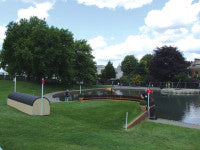
"Up to two million people a year use the park, and the areas where we were working could be filled with families picnicking, children playing and dog walkers, so our machinery operators had to be very focused," says Lee. "We tried to do as much as possible early in the morning, but having good operators was essential - they are all qualified to MSc level, and are well aware of the health and safety requirements."
They also found themselves taking on a PR role. The decision to host the equestrian events in Greenwich Park had been controversial from the start, with protesters concerned about damage to the park and impact on the community. Despite a concerted publicity campaign and the backing of the council, formal protests took place at the test event and objectors have continued to make their feelings known to the media.
"We would get fifteen to twenty people a day stop us and ask what was going on. Local objectors have made their feelings known but, in general, we found people to be very positive. We aimed to make any disruption minimal and most residents are excited by the potential benefits," commented Lee.
LOCOG Equestrian Manager, Tim Hadaway, said: "LOCOG engaged STRI as its contractor because of their expertise in ecological work, and they have worked a miracle, taking sparse, desert-like terrain to a lush green surface resembling a golf course.
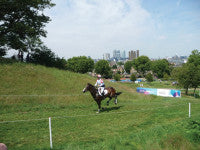 "The standards required for equestrian sport have risen dramatically since Sydney 2000, when I first became involved at this level - the quality of riding surface has to be as good as a racecourse, or better."
"The standards required for equestrian sport have risen dramatically since Sydney 2000, when I first became involved at this level - the quality of riding surface has to be as good as a racecourse, or better."
He added: " The FEI's technical delegate walked the course with me before the test event and he was highly impressed with what has been achieved."
Lee added that the surface is performing at about eighty percent of the quality that it will be for 2012.
"We are almost there with the turf establishment but, as it is not a closed site, we have to deal with damage from public use. Charlton Athletic also use the park for training, and it is the start and warm up area for the London Marathon, so we are working closely with the organisers for next year's event!"
The test event and beyond
LOCOG has planned eighteen test events for the Olympic Games - of which the equestrian event was the first - involving 5,000 athletes and attended by 250,000 spectators.
The objective of a test event is to test the 'field of play', i.e. the venue, the technology (scoring/timing/results) and the contractors and workforce. The cross country course was about half the length that will be used for the Olympic event itself, but was representative of the track and terrain that will challenge horses and riders in 2012.
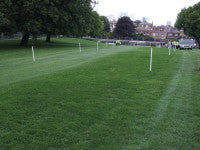 "We are very pleased with how it has gone," commented Lee. "The turf behaved pretty much as expected. One or two shaded areas have cut up, which we were prepared for, and we will cut those out and returf. We will also continue to work on the areas of the course that were not used for the test event and bring the entire track up to the same standard."
"We are very pleased with how it has gone," commented Lee. "The turf behaved pretty much as expected. One or two shaded areas have cut up, which we were prepared for, and we will cut those out and returf. We will also continue to work on the areas of the course that were not used for the test event and bring the entire track up to the same standard."
The test event also provided an opportunity to get feedback from some of the sport's most experienced competitors: Australian team member Clayton Fredericks said after the test event cross country: "It was a little bit slippery around the bends. Maybe they could think about banking the corners to protect the horses."
Lee explained: "The slippery corner was down to an issue with the placing of a jump immediately before an adverse camber. Therefore, one or two horses put their back legs in a low section upon landing, hence the slip. It was, luckily, not a footing issue. We will take heed of this, however, and ensure that the hairpin bends are worked on particularly to get the strongest possible rooting."
The event was won by British rider Piggy French, who said: "As you walk into the park you get goosebumps. The organisers have done a great job with the stabling, the arenas and the cross-country course. It's going to be fabulous and I can't wait to come back."
STRI has now returned to a maintenance phase - mowing, watering and aerating for the rest of 2011. After a 'quiet winter', preparations for the Olympic event, which starts on 29th July 2012, begin in earnest in March.
"We were watering for ten hours a day in the run up to the test event, and have contingency plans in place for whatever the weather throws at us over the next year," commented Lee. "If it turns wet, we will keep machinery off the course and use smaller equipment wherever possible. The test event has shown us that the surface works for equestrian sport at this level, and we can now build on it for 2012."
Equestrian events at the Olympics
Part of the Olympics since 1900, equestrian disciplines are the only Olympic sports in which men and women compete on an equal footing.
Greenwich Park will host Dressage and Paralympic Dressage, Showjumping, Eventing (a three phase sport comprising dressage, cross country and showjumping) and Modern Pentathlon.
Facilities include a 5800m cross country course (2800m of which was used for the test event), 90x113m all weather surface arena, stabling, grass and all weather practice arenas.
The Olympics and the community
Greenwich Council has been closely involved in the management and restoration of the site; leader Chris Roberts points out that the Games benefits local employment and businesses, and will drive tourism in the area.
It has committed £20m to the project, which will include raising twelve parks to Green Flag status, planting numerous trees and making improvements to children's play facilities.
The community has also been involved - local schoolchildren will help to design a 'Greenwich' jump for the cross country course and, when 1,000 tickets were offered for the equestrian test event, the council received 12,000 applications.
 The all weather arena
The all weather arena
All weather competition and practice areas have been installed by contractor Andrews Bowen to give the consistent footing required for high traffic during dressage and jumping events
The main arena, constructed by The Structure Group, is on 2,000 stilts to avoid penetrating the surface of the park. Each stilt can be adjusted for height via a screw mechanism. A membrane and blinding layer is overlaid with a plastic box section drainage layer, and then topped with a sand and fibre mix. This can be harrowed to provide a 'fluffy' surface for horses, but was also rolled and compacted for the running and shooting phases of the modern pentathlon test event.
A grandstand with 2,000 seats was installed for the test event but, in 2012, 22,000 spectators will enjoy a birds' eye view across London from their seats.
 Veteran trees
Veteran trees
Greenwich Park has more veteran trees than any other park in the country, and protecting their roots from damage is essential. No vehicle heavier than a golf buggy can drive in their root area, and their surrounds are woodchipped to avoid damage by the horses' hooves.
Greenwich Park
The 73ha park is London's oldest Royal Park, created in 1433, and has been a World Heritage Site since 1997. It was a gift from King James I to his wife Queen Anne, who commissioned a home for herself on the site, now known as the Queen's House and providing the backdrop to the main arena.
It has numerous archaeological features, veteran trees and protected species, and is home to many historic buildings include the Royal Observatory, Royal Naval College and National Maritime Museum.
LOCOG has worked closely with the Royal Parks, Natural England, English Heritage and Sport England to ensure that all their needs are met during the construction phase.
After the games, the park will be restored to the Royal Parks' satisfaction, with the final sign off in 2015.
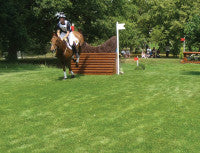 Roman temple revived
Roman temple revived
This fence is on the site of a Roman temple which had been repeatedly excavated, leaving a rough, damaged surface. Local archaeologists excavated the site once more to the ruin, and mapped and charted it fully before it was capped and turfed by the contractors.
"This is our part of the legacy - the temple is now protected and won't be dug up again," explains Lee.
Timeline
September 2008: STRI invited to take part in scoping exercise to determine if the event could be held in Greenwich Park
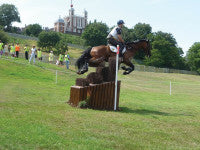 September 2009: Planning application submitted
September 2009: Planning application submitted
March 2010: Planning consent granted by Greenwich Council
August 2010: Ground preparation work begins
4-6th July 2011: Equestrian test event
7th July: Cross country fences removed and public access returned to much of the park
8-10th July: Modern Pentathlon test event for riding, running and laser shooting
Autumn 2011: Acid grassland enhancement project to mitigate temporary loss
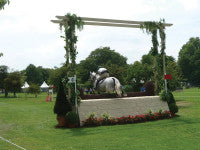 Winter 2012: Preparation of Olympic cross country course and testing of surfaces at STRI HQ in Bingley
Winter 2012: Preparation of Olympic cross country course and testing of surfaces at STRI HQ in Bingley
Spring 2012: Watering, seeding, fertilising of the course. Small scale turfing works to protect sensitive tree roots
June: Final preparations and design tweaks with Sue Benson, course designer, on the presentation of the course
28th July - 9th August: London 2012 Equestrian events
Post event: Autumn 2012-2015 STRI will carry out a full restoration of all areas of the park affected by the cross country course. This includes following detailed ecological restoration plans agreed by Natural England and the Royal Parks.
